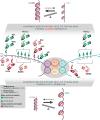Mendelian disorders of the epigenetic machinery: tipping the balance of chromatin states
- PMID: 25184531
- PMCID: PMC4406255
- DOI: 10.1146/annurev-genom-090613-094245
Mendelian disorders of the epigenetic machinery: tipping the balance of chromatin states
Abstract
Mendelian disorders of the epigenetic machinery are a newly delineated group of multiple congenital anomaly and intellectual disability syndromes resulting from mutations in genes encoding components of the epigenetic machinery. The gene products affected in these inherited conditions act in trans and are expected to have widespread epigenetic consequences. Many of these syndromes demonstrate phenotypic overlap with classical imprinting disorders and with one another. The various writer and eraser systems involve opposing players, which we propose must maintain a balance between open and closed chromatin states in any given cell. An imbalance might lead to disrupted expression of disease-relevant target genes. We suggest that classifying disorders based on predicted effects on this balance would be informative regarding pathogenesis. Furthermore, strategies targeted at restoring this balance might offer novel therapeutic avenues, taking advantage of available agents such as histone deacetylase inhibitors and histone acetylation antagonists.
Keywords: DNA methylation; chromatin; epigenetics; epigenomics; histone tail modifications; therapeutic development.
Figures



Similar articles
-
Mendelian disorders of the epigenetic machinery: postnatal malleability and therapeutic prospects.Hum Mol Genet. 2019 Nov 21;28(R2):R254-R264. doi: 10.1093/hmg/ddz174. Hum Mol Genet. 2019. PMID: 31595951 Free PMC article. Review.
-
Epigenetics in the nervous system.J Neurosci. 2008 Nov 12;28(46):11753-9. doi: 10.1523/JNEUROSCI.3797-08.2008. J Neurosci. 2008. PMID: 19005036 Free PMC article. Review.
-
Developmental disorders with intellectual disability driven by chromatin dysregulation: Clinical overlaps and molecular mechanisms.Clin Genet. 2019 Feb;95(2):231-240. doi: 10.1111/cge.13365. Epub 2018 May 21. Clin Genet. 2019. PMID: 29672823 Review.
-
Epigenetic regulation of memory by acetylation and methylation of chromatin: implications in neurological disorders, aging, and addiction.Neuromolecular Med. 2015 Jun;17(2):97-110. doi: 10.1007/s12017-014-8306-x. Epub 2014 Apr 29. Neuromolecular Med. 2015. PMID: 24777294 Review.
-
Linking epigenetics to lipid metabolism: focus on histone deacetylases.Mol Membr Biol. 2012 Nov;29(7):257-66. doi: 10.3109/09687688.2012.729094. Epub 2012 Oct 24. Mol Membr Biol. 2012. PMID: 23095054 Review.
Cited by
-
Beyond the exome: what's next in diagnostic testing for Mendelian conditions.ArXiv [Preprint]. 2023 Jan 18:arXiv:2301.07363v1. ArXiv. 2023. Update in: Am J Hum Genet. 2023 Aug 3;110(8):1229-1248. doi: 10.1016/j.ajhg.2023.06.009. PMID: 36713248 Free PMC article. Updated. Preprint.
-
Rubinstein-Taybi 2 associated to novel EP300 mutations: deepening the clinical and genetic spectrum.BMC Med Genet. 2018 Mar 5;19(1):36. doi: 10.1186/s12881-018-0548-2. BMC Med Genet. 2018. PMID: 29506490 Free PMC article.
-
DNA Methylation in the Diagnosis of Monogenic Diseases.Genes (Basel). 2020 Mar 26;11(4):355. doi: 10.3390/genes11040355. Genes (Basel). 2020. PMID: 32224912 Free PMC article. Review.
-
Interplay between Histone and DNA Methylation Seen through Comparative Methylomes in Rare Mendelian Disorders.Int J Mol Sci. 2021 Apr 3;22(7):3735. doi: 10.3390/ijms22073735. Int J Mol Sci. 2021. PMID: 33916664 Free PMC article.
-
Integration of multi-omics technologies for molecular diagnosis in ataxia patients.Front Genet. 2024 Jan 4;14:1304711. doi: 10.3389/fgene.2023.1304711. eCollection 2023. Front Genet. 2024. PMID: 38239855 Free PMC article.
References
-
- Alarcón JM, Malleret G, Touzani K, Vronskaya S, Ishii S, et al. Chromatin acetylation, memory, and LTP are impaired in CBP+/− mice: a model for the cognitive deficit in Rubinstein-Taybi syndrome and its amelioration. Neuron. 2004;42:947–59. - PubMed
-
- Amir RE, Van den Veyver IB, Wan M, Tran CQ, Francke U, et al. Rett syndrome is caused by mutations in X-linked MECP2, encoding methyl-CpG-binding protein 2. Nat Genet. 1999;23:185–88. - PubMed
-
- Arnaud P, Feil R. Epigenetic deregulation of genomic imprinting in human disorders and following assisted reproduction. Birth Defects Res C. 2005;75:81–97. - PubMed
Publication types
MeSH terms
Substances
Grants and funding
LinkOut - more resources
Full Text Sources
Other Literature Sources
Medical

